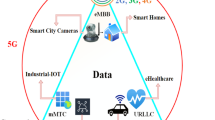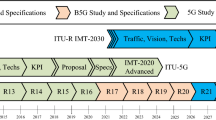Abstract
The traditional channel sounding protocol requires that the whole sounding process must be completed within a coherent time. When the communication delay is close to or greater than the coherent time, the protocol will not work properly. In order to solve this problem, a novel Non-Time-Limited channel sounding protocol is proposed. The proposed channel sounding protocol does not need to guarantee the channel reciprocity, has no limit on the communication delay and has strong multi-relay scalability. At the same time, a relay-assisted security extension mechanism is proposed to prevent the collaborative eavesdropping of the neighboring attackers. Simulation experiments show that the Non-Time-Limited channel sounding protocol can get rid of the influence of channel change speed on key generation, effectively improve key consistency in high-speed mobile scenarios, and still maintain good key agreement rate performance in underwater acoustic communication.










Similar content being viewed by others
References
Rivest, R. L. (1978). A method for obtaining digital signatures and public-key cryptosystems. Communication of ACM, 21(2), 1–7.
Wang, T., Liu, Y., & Vasilakos, A. V. (2015). Survey on channel reciprocity based key establishment techniques for wireless systems. Wireless Networks, 21(6), 1–12.
Liu, Y., Hsiao-Hwa, C., & Liangmin, W. (2017). Physical layer security for next generation wireless networks: Theories, technologies, and challenges. IEEE Communications Surveys & Tutorials, 19(1), 347–376.
Maurer, U. M. (1993). Secret key agreement by public discussion from common information. IEEE Transactions on Information Theory, 39(3), 733–742.
Liu, J., Hu, Q., Suny, R., Duz, X., & M. Guizani. (2020). A physical layer security scheme with compressed sensing in ofdm-based iot systems. In ICC 2020–2020 IEEE International Conference on Communications (ICC) (pp. 1–6).
Han, Q., Liu, J., Shen, Z., Liu, J., & Gong, F. (2019). Vector partitioning quantization utilizing k-means clustering for physical layer secret key generation. Information Sciences, 512, 1171.
Moara-Nkwe, K., Shi, Q., Lee, G. M., & Eiza, M. H. (2019). A novel physical layer secure key generation and refreshment scheme for wireless sensor networks. IEEE Access, 6, 11374–11387.
Hajomer, A. A. E., Zhang, L., Yang, X., & Hu, W. (2020). Post-processing protocol for physical-layer key generation and distribution in fiber networks. IEEE Photonics Technology Letters, 32(15), 901–904.
Xu, P., Hu, D., & Chen G. (2020). Physical-layer cooperative key generation with correlated eavesdropping channels in iot. In: IEEE International Conference on Internet of Things (iThings) (pp. 29–36).
Shen, Z., Liu, J., & Han, Q. (2018). A local pilot auxiliary key generation scheme for secure underwater acoustic communication. Information Sciences, 473, 1–12.
Zan, B., Gruteser, M., & Hu, F. (2012). Improving robustness of key extraction from wireless channels with differential techniques. In 2012 International Conference on Computing, Networking and Communications (ICNC) (pp. 980–984).
Hou, X., Gao, C., Zhu, Y., & Yang, S. (2016). Detection of active attacks based on random orthogonal pilots. In 2016 8th International Conference on Wireless Communications Signal Processing (WCSP) (pp. 1–4).
Qin, D., & Ding, Z. (2016). Exploiting multi-antenna non-reciprocal channels for shared secret key generation. IEEE Transactions on Information Forensics and Security, 11, 2693–2705.
Ren, K., Su, H., & Wang, Q. (2011). Secret key generation exploiting channel characteristics in wireless communications. IEEE Wireless Communications, 18, 6–12.
Kong, Y., Lyu, B., Chen, F., & Yang, Z. (2018). The security network coding system with physical layer key generation in two-way relay networks. IEEE Access, 6, 40673–40681.
Xiao, S., Guo, Y., Huang, K., & Jin, L. (2017). High-rate secret key generation aided by multiple relays for internet of things. Electronics Letters, 53(17), 1198–1200.
Zhang, S., Jin, L., Lou, Y., & Zhong, Z. (2018). Secret key generation based on two-way randomness for tdd-siso system. China Communications, 15(7), 202–216.
Zhuang, Z., Jiang, S., Xu, Y., Luo, X., & Cheng, X. (2019). A physical layer key generation scheme based on full-duplex mode in wireless networks without fixed infrastructure. In: 2019 International Conference on Computer, Information and Telecommunication Systems (CITS) (pp. 1–5).
Han, J., Zeng, X., Xue, X., & Ma, J. (2020). Physical layer secret key generation based on autoencoder for weakly correlated channels. In 2020 IEEE/CIC International Conference on Communications in China (ICCC) (pp. 1220–1225).
Bakşi, S., & Popescu, D. C. (2019). Secret key generation with precoding and role reversal in mimo wireless systems. IEEE Transactions on Wireless Communications, 18(6), 3104–3112.
Li, G., Hu, A., Peng, L., & Sun, C. (2016). The optimal preprocessing approach for secret key generation from ofdm channel measurements. In 2016 IEEE Globecom Workshops (GC Wkshps) (pp. 1–6).
Acknowledgements
This work were supported in part by Joint Fund of Ministry of Education of China under Grant 6141A02022338 and Natural Science Basic Research Program of Shaanxi (Program No.2021JM-134).
Author information
Authors and Affiliations
Corresponding author
Additional information
Publisher's Note
Springer Nature remains neutral with regard to jurisdictional claims in published maps and institutional affiliations.
Rights and permissions
About this article
Cite this article
Jingmei, L., Zhiwei, S., Zhuangzhuang, R. et al. A Non-Time-Limited Channel Sounding Protocol for Key Generation. Wireless Pers Commun 120, 787–807 (2021). https://doi.org/10.1007/s11277-021-08490-4
Accepted:
Published:
Issue Date:
DOI: https://doi.org/10.1007/s11277-021-08490-4




